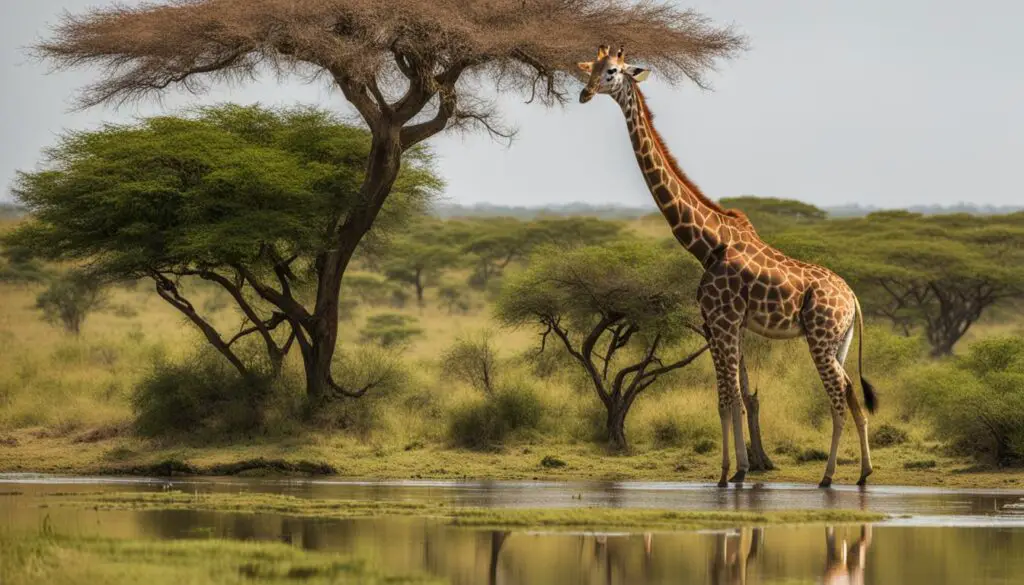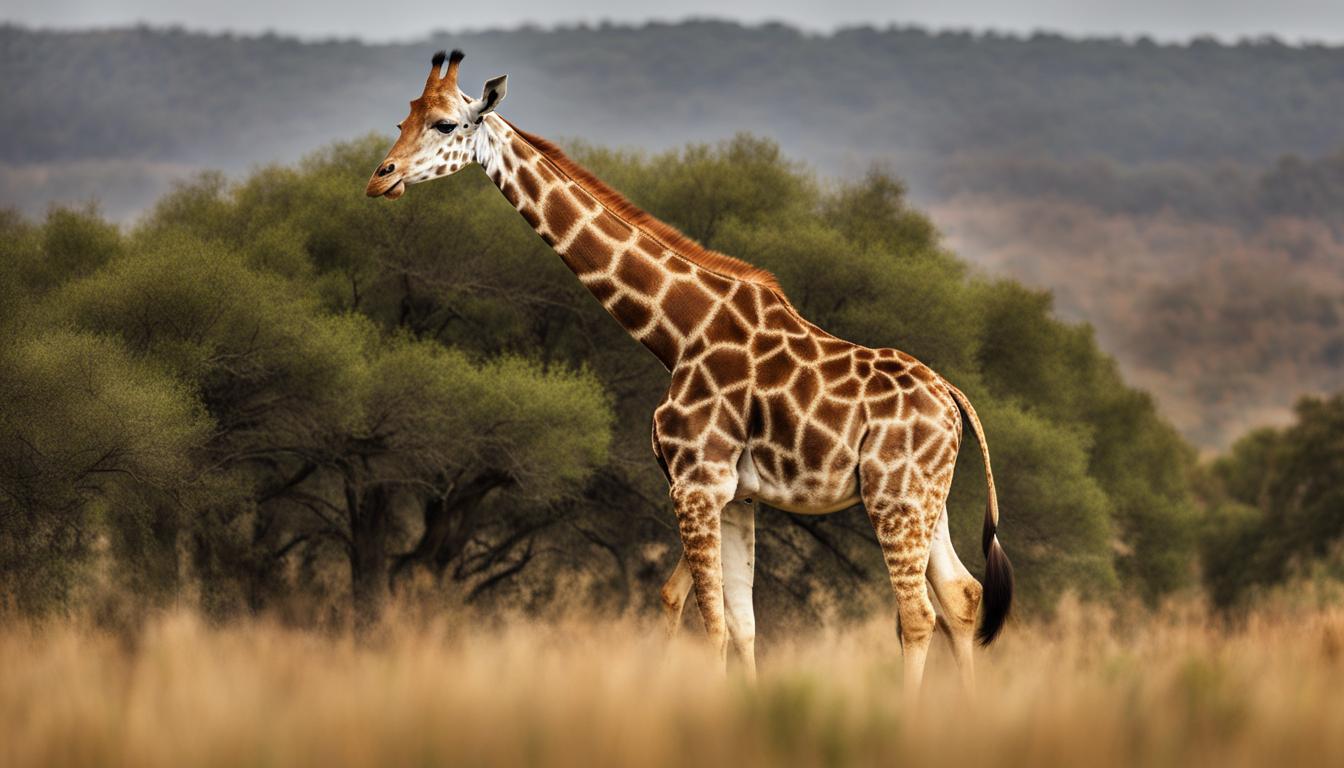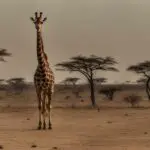Giraffes are fascinating creatures that have undergone remarkable adaptations to thrive in their diverse environments. These adaptations include both physical and behavioral changes that enable them to obtain food, avoid predators, and survive in their habitats.
From their long necks and specialized tongues to their keen senses and defensive abilities, giraffes have evolved unique traits that make them highly adaptable and successful in the wild. These adaptations allow them to navigate their habitat, camouflage themselves from predators, and access food sources that other animals cannot reach.
In this article, we will explore the various adaptations of giraffes, from their physical characteristics to their survival strategies. We will delve into how their long necks, legs, and tongues aid in feeding, their exceptional eyesight and hearing for detecting predators, and their ability to go without water for extended periods of time.
Join us on this journey to uncover the incredible resilience and adaptability of giraffes, and gain a deeper appreciation for these majestic creatures.
Giraffe Physical Adaptations
Giraffes have evolved a range of physical adaptations that enable them to thrive in their unique environments. One of the most distinctive features of giraffes is their long necks, which allow them to reach food sources that other animals cannot access. This adaptation gives them a competitive advantage in areas with tall trees and sparse vegetation. The long neck also enables giraffes to browse leaves from high branches, reducing competition for food.
Along with their long necks, giraffes have exceptionally long legs that aid them in their quest for food. The length of their legs allows giraffes to cover great distances with fewer steps, making it easier for them to navigate their habitats efficiently. This adaptation is especially useful in open grasslands where visibility is high, allowing them to spot potential predators or food sources from a distance.
Furthermore, giraffes have a unique tongue that is not only long but also dexterous. Their tongues can extend up to 18 inches in length, enabling them to pluck leaves from thorny branches without getting injured. The prehensile nature of their tongue allows giraffes to wrap it around branches and strip leaves with precision. This adaptation ensures they can access food sources that would otherwise be off-limits.
| Physical Adaptation | Description |
|---|---|
| Long neck | Enables giraffes to reach food sources that other animals cannot access |
| Long legs | Aids in covering great distances efficiently and enhancing visibility in open grasslands |
| Tongue | Long and dexterous, allowing giraffes to pluck leaves from thorny branches without injury |
| Heart and circulatory system | Powerful heart and four-chambered stomachs to process fibrous diet and maintain blood flow |
| Feet | Two digits on each foot provide stability and support |
The giraffe’s physical adaptations are not limited to their necks, legs, and tongues. They also possess a large heart and four-chambered stomachs that allow them to efficiently process their fibrous diet. This adaptation enables giraffes to extract the necessary nutrients from leaves and digest their food effectively. Additionally, their feet have two digits that provide stability and support their massive body weight, aiding in their posture and movement.
Overall, giraffes have evolved a remarkable set of physical adaptations that enable them to survive and thrive in their environments. These adaptations, including their long necks, legs, and tongues, along with their specialized circulatory and digestive systems, give them a unique advantage in accessing food and navigating their habitats.
Giraffe Behavioral Adaptations
Giraffes have evolved a range of behavioral adaptations that contribute to their survival in the wild. These adaptations allow them to navigate their environment, detect potential threats, and defend themselves against predators.
One of the key behavioral adaptations of giraffes is their exceptional eyesight, which enables them to spot movement up to a mile away. This acute vision allows them to detect predators from a distance and gives them a crucial advantage in avoiding potential dangers. Combined with their height advantage, giraffes have an excellent vantage point to scan their surroundings.
In addition to their remarkable eyesight, giraffes also possess superior hearing. Their large ears are specially adapted to pick up the faintest sounds, helping them detect potential threats or the approach of predators. This acute sense of hearing is essential for their survival in their natural habitat.
Quote: “Giraffes have an excellent vantage point to scan their surroundings.”
Giraffes also employ a unique form of camouflage through their spotted coat pattern. This pattern helps them blend into the dappled light and shadows of their dry savanna habitat, making it harder for predators to spot them. It acts as a natural disguise, providing an added layer of protection against potential threats.
| Giraffe Behavior | Description |
|---|---|
| Running Speed | Giraffes can reach impressive speeds of up to 35 miles per hour in short bursts. This ability allows them to quickly escape from predators. |
| Kicking Abilities | Giraffes have powerful kicks that can both defend against predators and establish dominance within their social hierarchy. |
With their combination of keen eyesight, acute hearing, and effective camouflage, giraffes have developed a set of behavioral adaptations that enable them to thrive in their unique habitat. These adaptations contribute to their survival and highlight the remarkable resilience of these magnificent creatures.
Giraffe Feeding Adaptations
Giraffes have developed unique feeding adaptations that allow them to survive in their challenging habitats. One of the most remarkable adaptations is their long neck, which enables them to reach leaves on tall trees that other herbivores cannot access. With their necks stretching up to six feet long, giraffes can effortlessly feed on leaves that are out of reach for most animals. This adaptation gives them a competitive advantage in finding food resources.
Another important feeding adaptation of giraffes is their specialized tongue. Their tongues can measure up to 20 inches long and are incredibly flexible and tough. This allows giraffes to wrap their tongues around branches and pull off leaves without being harmed by thorns or spines. The tongue is also covered in a thick layer of saliva, providing a protective barrier against potential injuries from sharp plant parts. This adaptation ensures that giraffes can efficiently feed on their preferred food sources without risking damage to their mouths.
Additionally, giraffes have adapted to obtain a significant portion of their water intake from the plants they consume. In their arid habitats, where water sources may be scarce, giraffes have evolved the ability to go for long periods without drinking water directly. By consuming leaves that contain a high moisture content, they can meet their hydration needs. Their bodies have also developed mechanisms to conserve water, allowing them to thrive in environments with limited access to water sources.
| Giraffe Feeding Adaptations | Description |
|---|---|
| Long Neck | Allows giraffes to reach leaves on tall trees |
| Specialized Tongue | Flexible and tough tongue for grasping leaves and protecting against thorns |
| Water Intake | Giraffes obtain water from the plants they consume and have the ability to go without drinking for extended periods |
Giraffes’ feeding adaptations have played a vital role in their survival and ability to thrive in diverse ecosystems. These unique features allow them to access food sources that other herbivores cannot reach and overcome the challenges of their arid environments.
Giraffe Survival Strategies
Giraffes have developed unique survival strategies that enable them to thrive in their environments. These strategies include leveraging their height advantage, utilizing their exceptional eyesight, adapting to go without water for extended periods, and employing effective camouflage.
Height Advantage
One of the key survival strategies of giraffes is their height advantage. With their long necks, giraffes can access food sources that other animals cannot reach. This allows them to minimize competition for resources and ensures a consistent food supply, even in environments with sparse vegetation.
Exceptional Eyesight
Giraffes possess remarkable eyesight, which plays a crucial role in their survival. Their acute vision allows them to spot predators from a distance, giving them ample time to react and escape potential threats. This keen eyesight also helps giraffes navigate their surroundings, avoiding obstacles and identifying suitable foraging areas.
Adaptation to Go Without Water
Giraffes have the ability to survive for long periods without water, making them well-suited to arid environments. They have adapted to obtain a significant portion of their water needs from the moisture-rich vegetation they consume. This adaptation enables them to thrive in areas where water sources may be scarce or far apart.
Effective Camouflage
The giraffe’s unique coat pattern provides effective camouflage in their habitats, particularly in the dry savannas. The intricate spots on their bodies help break up their outline, making it harder for predators to spot them amidst the trees and tall grasses. This camouflage provides giraffes with an added layer of protection and increases their chances of survival.

| Survival Strategies | Description |
|---|---|
| Height Advantage | Giraffes can access food sources that are out of reach for other animals, minimizing competition. |
| Exceptional Eyesight | Giraffes have keen eyesight, allowing them to spot predators and navigate their surroundings effectively. |
| Adaptation to Go Without Water | Giraffes can survive for long periods without water by obtaining moisture from the vegetation they consume. |
| Effective Camouflage | The giraffe’s spotted coat pattern provides camouflage, making it harder for predators to spot them. |
Giraffe Habitat and Adaptations
Giraffes are fascinating creatures that have adapted to thrive in various habitats. Their adaptability is evident in their physical and behavioral traits, which enable them to survive and succeed in their specific environments.
Giraffes primarily inhabit open woodlands and dry savannas, with a preference for areas that have trees, particularly acacia trees. These habitats provide the giraffes with the necessary food sources and cover. The tall trees in these ecosystems are crucial for their survival as they allow the giraffes to access leaves that are unavailable to other herbivores. The specific adaptations of giraffes help them take full advantage of their preferred habitats.
Giraffe Adaptations
One of the most notable adaptations of giraffes is their long necks, which allow them to reach leaves high up in the trees. By stretching their necks and using their long tongues, giraffes can effortlessly grab the nutrient-rich foliage that other animals cannot access. This adaptation ensures a steady food supply, even in areas with limited resources.
Furthermore, giraffes have developed a unique cardiovascular system to cope with the challenges posed by their long neck. Their heart is particularly large and powerful, allowing for efficient blood circulation throughout their bodies. This adaptation enables them to pump blood against gravity to their heads without any adverse effects. As a result, giraffes can maintain the blood flow necessary to power their extended necks.
Additionally, giraffes’ legs have adapted to their habitat. Their long and powerful legs enable them to navigate various terrains, including the uneven savanna floor, with ease. Giraffes possess two digits on each foot, which provide stability and support as they move. This adaptation allows them to travel over long distances to reach new food sources and water holes.
| Adaptation | Description |
|---|---|
| Long Neck | Allows giraffes to reach high leaves in the trees |
| Large Heart | Enables efficient blood circulation to power the long neck |
| Powerful Legs | Aids in navigating various terrains and traveling long distances |
By understanding the unique habitat and adaptations of giraffes, we can appreciate their remarkable ability to thrive in diverse environments. Their long necks, powerful hearts, and strong legs have all contributed to their success in accessing food and surviving in their chosen habitats. Giraffes truly exemplify the wonders of nature and the incredible ways in which animals adapt to their surroundings to ensure their survival.
Conclusion
Giraffes have evolved remarkable adaptations that allow them to thrive in their unique environments. Their physical characteristics, such as their long necks and specialized tongues, play a crucial role in their survival. The long neck enables giraffes to reach food sources that other animals can’t access, while their long and flexible tongues enable them to strip leaves from thorny branches without harm.
Behavioral adaptations also contribute to the giraffe’s success. With exceptional eyesight and keen hearing, giraffes can detect predators from afar and take necessary evasive actions. Their spotted coat pattern provides effective camouflage in the dry savanna, helping them blend in with their surroundings and avoid detection.
Survival strategies, including the ability to go without water for long periods and quick consumption of large quantities when available, allow giraffes to adapt to their environment’s challenges. By understanding and appreciating the incredible adaptations of giraffes, we gain profound insight into the resilience and adaptability of these extraordinary creatures.
How have the adaptations of giraffes influenced their migratory behavior?
The giraffe migration patterns and driving factors have played a significant role in shaping their migratory behavior. These adaptations, such as their long legs and necks, allow them to traverse long distances to find food and water. Additionally, their ability to consume leaves from tall trees contributes to their nomadic behavior, as they constantly seek areas with abundant vegetation. These adaptations have shaped the migratory instincts of giraffes, enabling them to thrive in diverse habitats.
FAQ
How have giraffes adapted to their environments?
Giraffes have undergone various adaptations, both physical and behavioral, to thrive in their diverse environments. These adaptations include long necks, specialized tongues, keen senses, and defensive abilities.
What are the physical adaptations of giraffes?
Giraffes have long necks, legs, and tongues that aid in reaching food sources. They also have a large heart, four-chambered stomachs, and two-digit feet for processing their fibrous diet and maintaining stability.
What are the behavioral adaptations of giraffes?
Giraffes have excellent eyesight and hearing to detect predators. Their spotted coat pattern helps them blend in with their surroundings, and they can run at high speeds and deliver powerful kicks for self-defense.
How do giraffes adapt for feeding?
Giraffes use their long necks and prehensile tongues to reach leaves on thorny branches without harming themselves. They also have a thick coating of saliva in their mouths to protect against injuries from sticks and thorns. They can obtain much of their water needs from the food they eat.
What are giraffes’ survival strategies?
Giraffes use their height advantage to access food sources, have excellent eyesight to spot predators, and can go for long periods without water. They also have adaptive mechanisms to quickly drink large amounts when needed and their camouflage helps protect them, especially during their early months of vulnerability.
Where are giraffes found and how do they adapt to their habitats?
Giraffes are found in various habitats, including open woodlands and dry savannas with trees, particularly acacia trees. They have developed physical and behavioral traits that allow them to thrive in these environments by accessing food, avoiding predators, and blending in with their surroundings.











